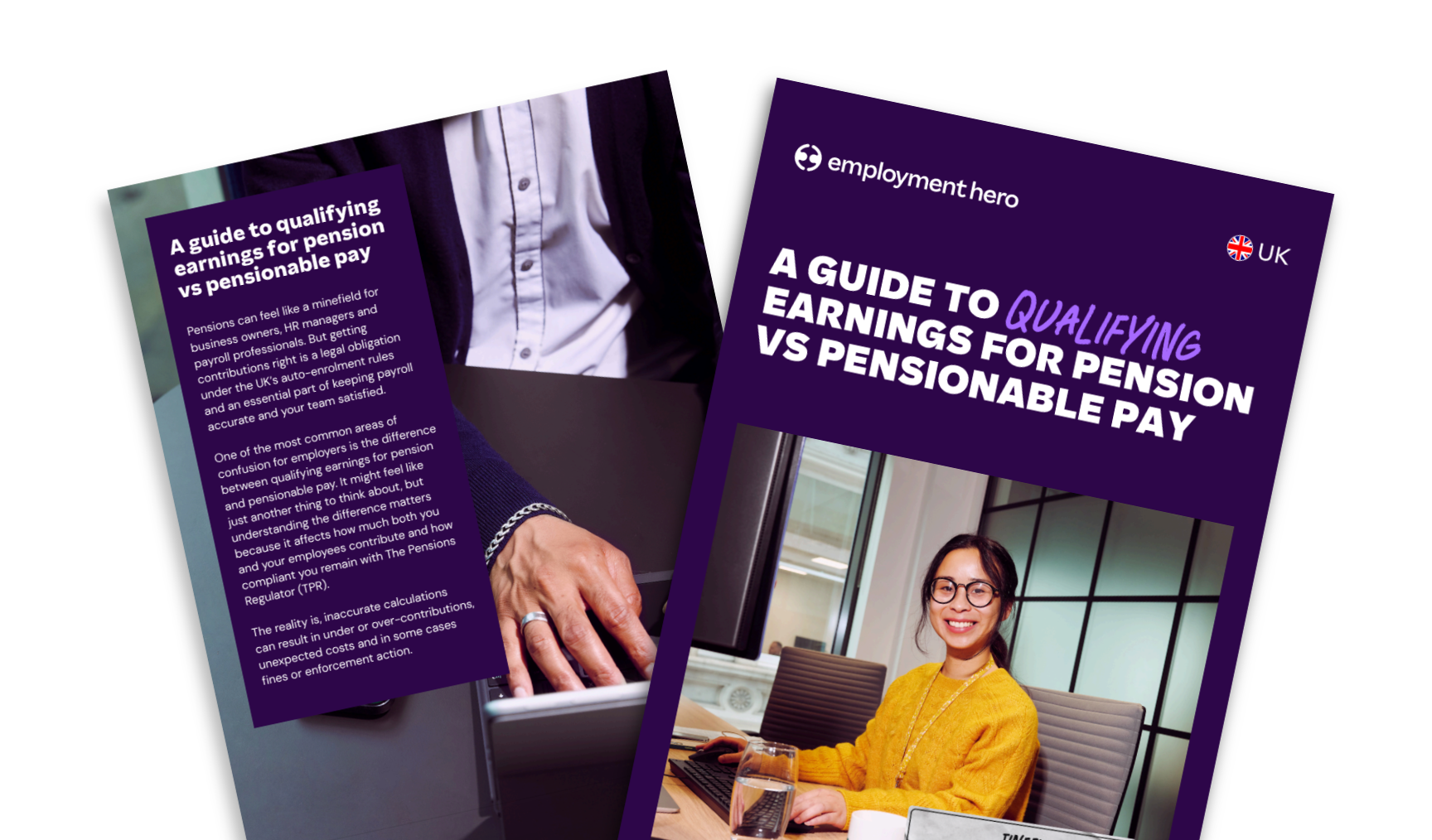Qualifying earnings for pension vs pensionable pay
Published
Qualifying earnings for pension vs pensionable pay
Published
Pensions can feel like a minefield for business owners, HR managers and payroll professionals. Getting contributions right though is a legal obligation under the UK’s auto-enrolment rules and an essential part of keeping payroll accurate and your team satisfied.
One of the most common areas of confusion for employers is the difference between qualifying earnings for pension and pensionable pay. It might feel like just another thing to think about, but understanding the difference matters because it affects how much both you and your employees contribute and how compliant you remain with The Pensions Regulator (TPR). The reality is, inaccurate calculations can result in under or over-contributions, unexpected costs and in some cases fines or enforcement action.
What are qualifying earnings for pension?
Under UK auto-enrolment legislation, employers must automatically enrol eligible workers into a scheme and contribute a minimum percentage of their earnings.
Qualifying earnings are defined by law and refer to a specific slice of an employee’s annual earnings that falls between the lower and upper earnings thresholds set by the government each tax year.
For the 2025/26 tax year, the thresholds remain unchanged from the previous year:
- Lower earnings threshold: £6,240 a year
- Upper earnings threshold: £50,270 a year
This means only earnings between £6,240 and £50,270 are used to calculate minimum contributions.
Pay elements included in qualifying earnings
Qualifying earnings for pension cover more than just basic salary. The following types of pay are included:
- Salary or wages.
- Overtime payments.
- Commission.
- Bonuses.
- Statutory pay (sick, maternity, paternity, adoption, shared parental pay).
This ensures that variable and supplementary pay is accounted for when calculating contributions, giving a fairer reflection of an employee’s overall income.
How to calculate qualifying earnings for pension
Understanding what qualifying earnings for pension is one thing, but you also need to know how to calculate it.
Here’s a breakdown:
- Identify total annual or pay-period earnings – add up all pay elements listed above.
- Apply the lower threshold (£6,240) – ignore any earnings below this figure.
- Apply the upper threshold (£50,270) – ignore any earnings above this figure.
- Calculate pension contributions – use the statutory minimum of 8% of qualifying earnings (5% employee, 3% employer) unless your scheme offers higher contributions.
Annual earnings example
Let’s take an employee with a total annual income of £36,000 (including salary, bonuses and overtime).
- Lower threshold = £6,240
- Upper threshold = £50,270
- Subtract the lower threshold: £36,000 – £6,240 = £29,760
- £36,000 is below the upper threshold, so no further adjustment is needed.
- Qualifying earnings = £29,760
If the pension scheme uses the statutory minimum of 8%:
- Employer contributes 3%: 3% × £29,760 = £892.80
- Employee contributes 5%: 5% × £29,760 = £1,488.00
- Total contributions = £2,380.80 per year
Monthly earnings example
Now let’s look at an employee earning £3,500 per month.
First, convert the thresholds to monthly figures:
- Lower monthly threshold = £6,240 ÷ 12 = £520
- Upper monthly threshold = £50,270 ÷ 12 ≈ £4,189
- Total monthly pay = £3,500
- Deduct lower threshold: £3,500 – £520 = £2,980
- £3,500 is below the upper threshold, so no further adjustment is needed.
- Qualifying earnings = £2,980
Monthly contributions at 8%:
- Employer contributes 3%: 3% × £2,980 = £89.40
- Employee contributes 5%: 5% × £2,980 = £149.00
- Total monthly contributions = £238.40
What are pensionable earnings (and how do they differ)?
While qualifying earnings are defined by law, pensionable earnings (sometimes called pensionable pay) are defined by each scheme’s rules.
Employers can choose to calculate contributions on:
- Basic pay only – usually excludes overtime, bonuses and commission.
- Total earnings – includes all elements of pay with no thresholds.
The choice matters because it can significantly affect contribution levels. Using basic pay only may lower contribution amounts (but still needs to meet minimum statutory requirements), while using total earnings often increases contributions but provides a more generous pension submission for employees.
What happens if an employee’s pay falls below the qualifying threshold?
It’s important to remember that not all employees will earn above the £6,240 lower threshold. There are several approaches businesses can take if this is the case:
- Employees earning less than £6,240: They can opt into the scheme, but you as the employer aren’t required to contribute unless they do.
- Employees earning between £6,240 and £10,000: They can opt in and if they do, the employer must also contribute.
- Employees earning above £10,000 and aged 22 to state pension age: They must be auto-enrolled and both employer and employee contributions apply.
- Earnings above £50,270: Contributions only apply to the first £50,270; income above this upper threshold isn’t included in qualifying earnings.
This tiered structure ensures contributions are proportionate to income while protecting lower-paid workers.
Choosing the right definition of earnings for your pension scheme
When setting up or reviewing your workplace scheme, one of the most important decisions you’ll make is which earnings definition to use to calculate contributions. This choice affects how much you and your employees pay in and it can influence everything from payroll complexity to employee satisfaction.
Qualifying earnings – default statutory method
- Contributions apply only to earnings between £6,240 and £50,270.
- Includes salary, overtime, bonuses, commission and statutory pay.
- Meets minimum auto-enrolment requirements and fairly reflects variable pay.
- Consideration: More complex to calculate due to thresholds.
Basic pay
- Based on basic salary only, excluding overtime, bonuses and commission.
- Easier to manage and budget for, but must be certified to meet statutory minimums.
- Consideration: Employees with variable pay may receive lower contributions.
Total pay
- Contributions apply to all earnings with no thresholds or exclusions.
- Simple to administer and valued by employees, boosting retention.
- Consideration: Usually higher employer costs, especially for bonus-heavy roles.
How to choose
- Variable pay roles: Qualifying or total pay better reflect actual earnings.
- Salaried staff: Basic pay offers simplicity and predictability.
- Talent attraction: Total pay is most competitive but costlier.
How qualifying earnings affect employer costs and compliance
Your choice of earnings basis—whether qualifying earnings for pension, basic pay, or total pay—directly influences your organisation’s costs, compliance obligations and employee experience.
Employer costs
A broader earnings definition (like total pay) increases contributions because it includes all pay elements.
- This can raise pension costs for commission-heavy or bonus-led roles but can also strengthen your benefits package.
- Narrower bases, like basic pay or qualifying earnings, help control costs but may reduce employee contributions.
Compliance risk
If contributions on basic pay fall below the legal minimum, your scheme must be certified to remain compliant.
- Failure to certify or calculate correctly can lead to underpayments, penalties and back-pay obligations.
Employee engagement
Employees often value transparent, inclusive contributions.
- Including all earnings can improve trust, morale and retention.
- Excluding bonuses or overtime may be seen as unfair unless clearly explained.
Regular scheme reviews
Review your pension scheme annually to stay compliant with TPR, keep contributions sustainable and ensure the approach still suits your workforce and pay structure.
Get pension contributions right with Employment Hero
Understanding the difference between qualifying earnings for pension and pensionable pay isn’t just an HR technicality, it’s fundamental to payroll accuracy, compliance and employee trust.
By applying the correct thresholds and choosing the right earnings basis for your scheme, you can prevent compliance headaches and manage costs effectively.
Employment Hero’s Employment Operating System (OS) can automate these calculations, keep you aligned with the latest thresholds and give employees clarity over their contributions.
Register for the downloadables
Related Resources
-
 Read more: Qualifying earnings for pension vs pensionable pay
Read more: Qualifying earnings for pension vs pensionable payQualifying earnings for pension vs pensionable pay
Learn the difference between qualifying earnings for pension and pensionable pay. Understand auto-enrolment, calculation methods, and compliance requirements.
-
 Read more: Paternity leave: An employer’s guide to rights and pay
Read more: Paternity leave: An employer’s guide to rights and payPaternity leave: An employer’s guide to rights and pay
A complete guide to UK paternity leave and pay for employers. Learn about rights, statutory pay, eligibility, adoption and surrogacy…



















